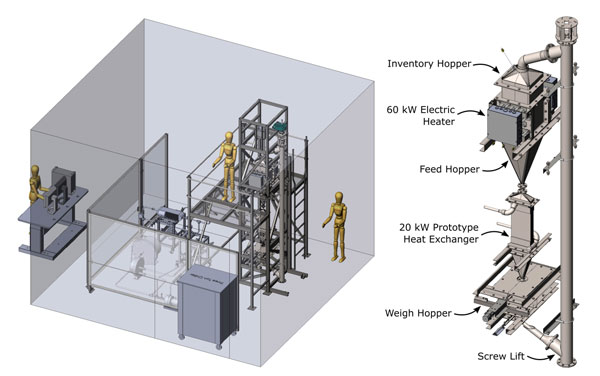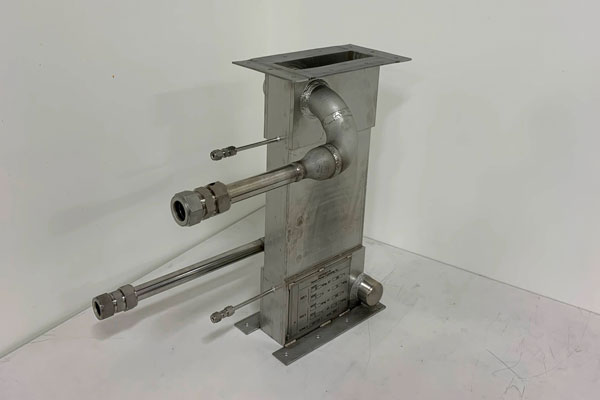
Sandia researchers have completed a two-year effort to evaluate heat exchanger performance for the Labs’ latest concentrating solar power project.
The DOE’s Solar Energy Technologies Office funded the $450,000 project to develop a small-scale test facility for particle-to-supercritical carbon dioxide, or sCO2, heat exchangers by creating flow loops for sCO2 and heated particles, and build a novel heat-exchanger that met performance requirements for Sandia’s larger role building and testing the $25 million DOE Generation 3 Particle Pilot Plant.
“This was a critical de-risking step to evaluate the performance and model predictions for the heat exchanger that allows us to then construct a much larger, one megawatt heat exchanger for the G3P3 project,” said Kevin Albrecht, project lead in the Labs’ concentrating solar power program.
The new particle flow loop can deliver up to 60 kilowatts of heat at 600 degrees C and a flow rate of 0.4 kilograms per second. The loop was developed to enable long-duration, off-sun testing of small prototype heat exchangers to produce model validation data at steady-state operating conditions.
Steady-state flows
By building the test facility, the team sought to alleviate common issues with heat exchangers. Their goal was to have the particle and sCO2 flows circulate indefinitely and achieve true steady-state operating conditions by maintaining accurate temperature control for the heat exchanger inlet.

Kevin said a real-world system would use solar energy to heat the particles and sCO2 to spin a turbine producing electrical energy, but for the project, the scientists designed a facility using electrical energy to heat particles passing through the two loops.
The Sandia team worked with companies it had worked with before — SOLEX Thermal Science and Vacuum Process Engineering — to come up with a design. They then measured the performance to be four to six times higher than any other known particle-to-sCO2 heat exchanger, Kevin said.
“Sandia and VPE have been working together for many years on the development of sCO2 heat exchangers for heat recuperation,” Kevin said, “and Sandia, VPE and Solex have been collaboratively developing primary power cycle heat exchangers for particle concentrating solar power since 2015.”
Development, testing continue
After the project concluded earlier this year, Kevin said the team received follow-on funding for continued development of the facility.
The researchers also will provide testing for outside customers. Heat exchanger vendors and universities that have novel concepts for heat exchangers will be able to bring their ideas to Sandia for assessment.
For now, the team will continue to develop a higher-temperature version of the heat exchanger and scale their current model for use in the broader Gen 3 CSP project.
“It is great to see this work moving forward, as well as the external interest in the project with some promising paths to commercialization,” Kevin said.
Members of the Sandia team included: Hendrik Frederik Laubscher, Christopher Paul Bowen, Cliff Ho, Robert Crandell, Roger Dean Buck, Daniel A. Ray, Lam Banh and former employee Matthew Carlson.
More information is available about Sandia’s Development and Testing of a 20 kW Moving Packed-Bed Particle-to-sCO2 Heat Exchanger and Test Facility, Concentrating Solar Power program and the Generation 3 CSP Systems (Gen 3 CSP) program.